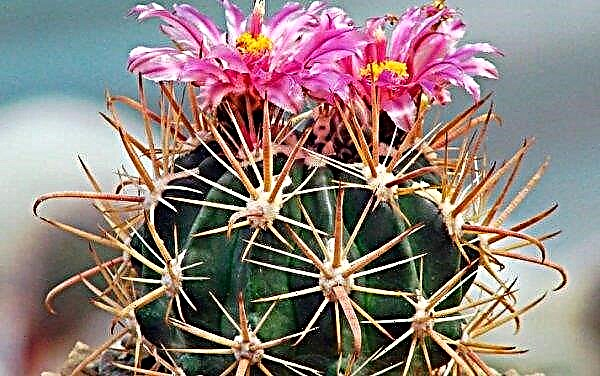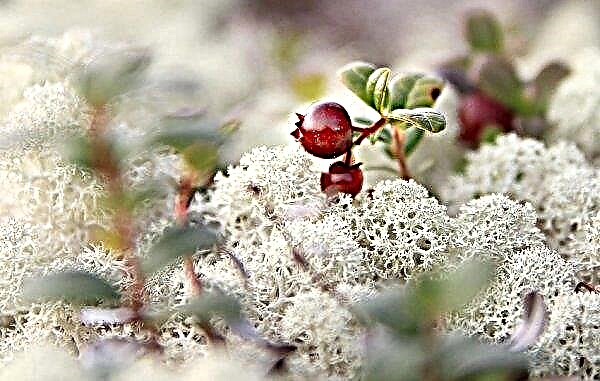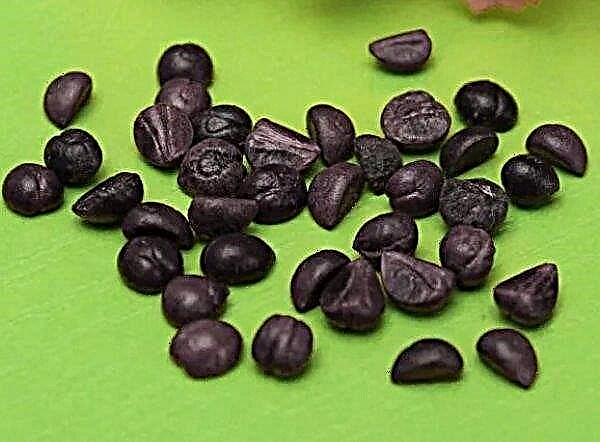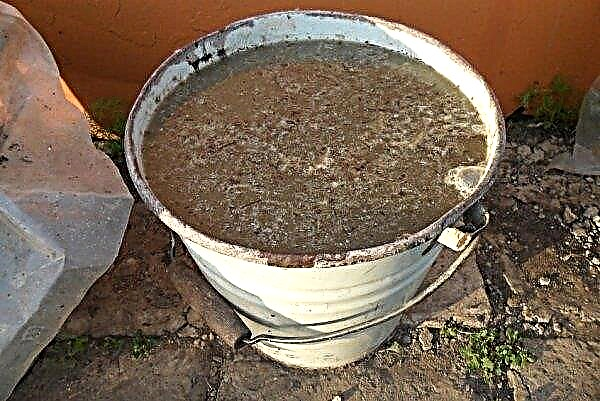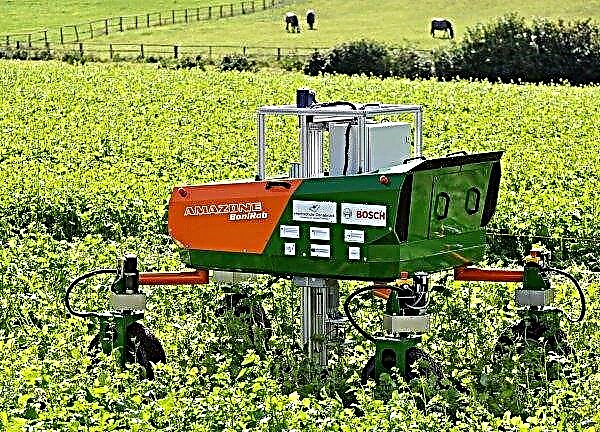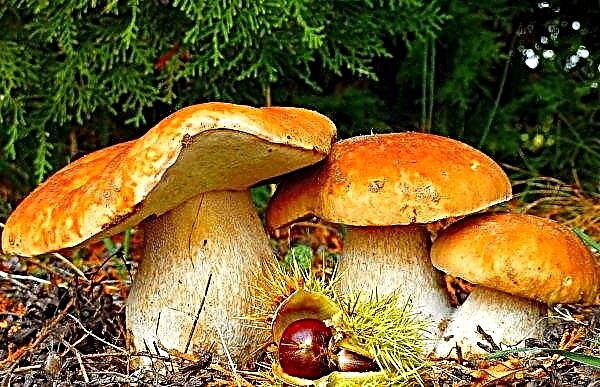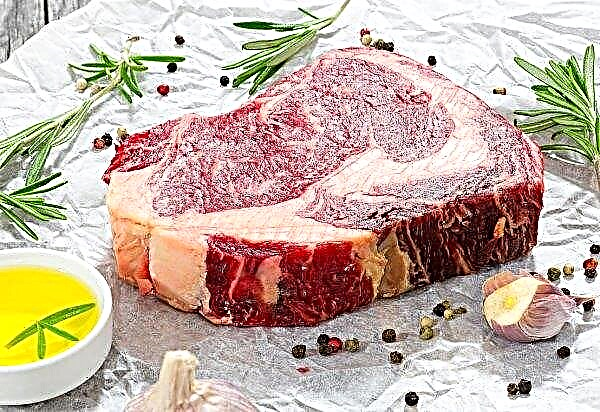Onions are popular for growing crops in our country. This vegetable is cultivated both on small garden beds, and on huge farm fields. In this article, we will consider what diseases are dangerous for onions, as well as the causes of their occurrence and methods of treatment.
General plant information
Onion (Allium cepa L.) is a biennial plant. In the first year of cultivation, he produces an underground bulb, from which white roots and fleshy, succulent green leaves grow. Both the underground and aboveground parts are edible. In the second year of growing, an adult bulb throws out shoots of inflorescences - their height can reach two meters, white or blue umbrellas from flowers are formed on them, from which seeds are subsequently formed.

Onions are susceptible to a number of diseases that can affect a wide variety of parts of the plant. Some of these diseases can lead to large crop losses if measures are not taken to protect and treat plantings. Diseases can be fungal, bacterial or viral. Compliance with a number of growing conditions may reduce the possibility of the onset and development of diseases.
Fungal diseases
Fungal diseases include alternariosis, peronosporosis, leaf anthracnosis, root rot, and botritis. In addition to fungal diseases, planting onions can cause serious damage to bacterial rot.
Important! Optimal for onion is a soil pH of 6.5–7.0. It is advisable to acidify soils with a pH below 6.0 by liming, however, this procedure should not be carried out simultaneously with fertilizing the beds with manure, since it causes rapid mineralization of the fertilizer and nitrogen loss from the soil.
Leaf
Some fungal diseases prefer the leafy part of the plant, and the entire cycle of their development takes place on the feathers of onions. These are diseases such as peronosporosis, alternariosis, or onion rust. Their description is given below.
Peronosporosis
Most types of onions (green, leek, etc.) are affected by this fungal disease. The most favorable atmosphere for the occurrence of peronosporosis occurs at an air temperature of + 20 ° C and high relative humidity - more than 80%. Spores of the fungus are transported over long distances along with diseased bulbs.

Peronosporosis causes significant damage to the culture in conditions of high humidity, with too close planting, irrigation irrigation and during periods of prolonged cooling. The intensity of attack of peronosporosis is also associated with an imbalance of nutrients, mainly phosphorus and potassium.
The fungus survives in plant debris, on bulbs used in planting, and on seeds. Distribution is carried out through infected bulbs, seeds, water and wind, with which the spores of the fungus travel over long distances.
Symptoms
- Initially, the affected areas appear in the form of dark lines on the bulbs, and then large elongated spots appear along the feathers. Lesions look like concentric zones of a discolored tissue and can be covered with whitish, beige, and sometimes purple mold.
- Plants grown from seeds infected with peronosporosis will lag behind in growth - as a result, the yield of bulbs or seed material will significantly decrease.
Did you know? Onion varieties differ in taste — their taste can be both spicy and soft. Bulbs with a sweet and mild flavor are often called sweet onions - they usually have white husks and snow-white, juicy and tender flesh.
Alternariosis
Fungal disease, the second name of which is downy mildew. Favorable conditions for its development are relative humidity of about 70% and high temperature. The pathogen survives on plant debris and weeds growing close to the onion bed, spreads mainly through the use of infected planting material, and spores can also be carried by rain and wind.

Seeds obtained from infected mother plants will be infected and can lead to serious losses during the cultivation of onion seedlings from them. If during the growing season regularly, for preventive purposes, to treat plantings with fungicides against downy and mildew mildew - it is possible to completely avoid the occurrence of these diseases on the culture. As protection, it is recommended to use fungicides from the strobilurin group, such as Amistar 250 SC. The product is used at the rate of 8 liters per hectare.
Symptoms
- Initially, whitish round, elongated or irregularly shaped spots form on the leaves, stems and bulbs, gradually increasing in size, with a dark center inside and purple borders that have a yellowish outer halo.
- Damage can increase, combined, and as a result cause the death of the sheet plate. Onion feathers also exhibit similar symptoms causing them to fall or dry out, which could jeopardize seed production. Infected bulbs are not suitable for long-term storage.
Rust
Various types of onions are susceptible to this disease - onions, leeks or onions are equally affected. Like many other pathogens, the rust pathogen hibernates in the beds, on uncleaned plant debris. Also, the source of the disease is perennial onions.
Symptoms
- In spring, green feathers of onions acquire red, a little later becoming brown-yellow, small warty spots that change color to black with the onset of summer.
- Green leaves die early in infected plants, and the bulbs stop growing - as a result, the grower will receive a small crop of small bulbs.
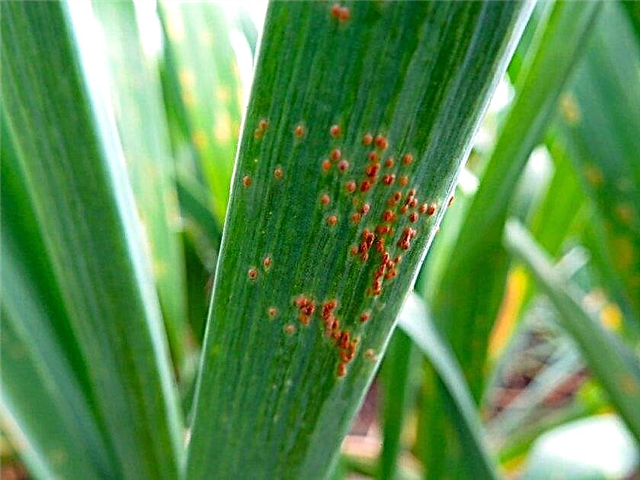
Bulbs
Some pathogens prefer to develop not on the leaves, but on the bulb - consider the following diseases: aspergillosis, fusarium rot of the base, cervical or green mold rot.
Neck rot
Cervical rot is a common disease of all onion varieties. The disease begins to develop after the harvest, its culprits are fungi of the genus Botrytis. Signs of the disease are difficult to see during the growing season of the crop or during the harvest.
Infection with cervical rot is also facilitated by agrotechnical errors - too rare sowing of onion seeds (the appearance of a thick neck) or excessive nitrogen fertilizer. The method of combating the disease is to eliminate all sources of primary infection. To do this, you should avoid growing crops by culture, especially if the summer is rainy.

It is also necessary to avoid excessively long drying of the crop in the field after digging. It is recommended to sow healthy seeds, preferably after treatment with a fungicide containing the active substance - tiuram. 2-3 weeks before harvesting, planting should be sprayed three times with an interval of 1 week. Amistar 250 SC fungicide (0.8 l / ha) or another from the same group of plant protection products is used for spraying. This procedure will also significantly improve the quality of the bulbs during long-term storage of vegetables.
Symptoms
- The spores of the fungus develop on the remains of the seed coat, then the cotyledon tissue dies from the apex, and later the tops of the leaves are also affected. Next comes the latent phase of the disease, progressing to the harvest period.
- The most dangerous infection occurs at the end of the onion growing season, that is, from the moment of the appearance of green feathers until the harvest. Infection most often causes the tips of the leaves to dry out and damage to the outer scales of the onion. In the upper part of the neck of the bulb, the tissue turns gray and begins to rot. During this period, an abundant gray coating may appear on the surface of the vegetable with black clusters - microsclerosis (a form of spore fungus).
Fusarium rot of the bottom
This disease often affects onion culture. Infection can occur at any stage of the growing season and, most likely, will lead to the death of the plant. The fungus is found in the soil, surviving for long periods in the form of stable structures (chlamydospores). Spores penetrate into plants through injuries in tissues obtained naturally or mechanically.
Important! After harvesting, it is necessary to dry the onions well in the sun so that the ultraviolet rays disinfect. The readiness of onions for storage is determined by the outer surface: if the husk is strong, golden and dry - the crop can be moved to the store.
The fungus develops during prolonged and heavy rains or irregular irrigation; its spores spread with the wind and seed received from infected seedlings. The development of the pathogen is promoted by a temperature of +26 ... + 28 ° C, and the spread of infection - high humidity.
Symptoms
- On the leaves, the disease begins with a yellowing of the tip and extends to the base of the onion neck.
- In diseased plants, the bulb turns brown.
- During the harvest period or during storage, rot occurs, which progresses and can cover the entire bulb.
- Fusariosis leads to the fact that the bottom of the bulb becomes dark and flat. During storage, healthy and diseased bulbs come into contact.

Green mold rot
Such mold often forms on onion flakes during prolonged storage. Spores of green mold rot winter without any problems in the soil, on top of the soil, on dried crop debris, in storage. The disease develops rapidly with high humidity in the room where vegetables are stored, or with partial freezing of onions.
Symptoms
- The first signs appear in the form of brown watery concentric zones on the bottom of the bulb (near the roots) and on the sides of the vegetable.
- Further on top of the spots and under them there is a coating, at the beginning of the disease whitish, a little later becoming green or bluish-green.

Aspergillosis
The cause of the disease is Aspergillus spores. The disease manifests itself mainly during the transport or storage of vegetables. Particularly quickly, the disease develops on green or poorly dried bulbs lying in storage in rooms with poor ventilation and high air temperature. The pathogen hibernates on plant debris, in soil, and on other crops. It develops rapidly at ambient temperatures above + 28 ° C.
Did you know? From time immemorial, onions have been stored in wreaths and braids. This was not done for decorative purposes. — onion heads were better kept hanging from the ceiling, where the air is always dry and warm.
Symptoms
- Sick vegetables often dry out, mummify.
- The disease can go into the secondary phase, causing wet decay of onions.
- Aspergillosis spores affect the plant even in the garden, but there are traces of the disease that are difficult to notice, except for the discoloration of the husks on the neck of the bulb.
- The mushroom picker looks like a black powder covering dry or juicy scales of a vegetable. In the future, aspergillosis gives the onion flakes a watery structure, after which the mycelium grows in them and the spores of the fungus mature.

Onion viral diseases
There is no effective treatment for diseases caused by viruses, so it is advisable to take preventive measures to avoid or reduce the infection of plants.
Mosaic
The causative agent of the mosaic is Allium virus 1 Smith. Especially prone to mosaic defeats are onions of the second year of vegetation, grown on seeds, and multi-tiered onions, while leek mosaic virus is not terrible. The onion mosaic virus has natural resistance to high and low temperatures, it does not die even after treatment with pepsin.
Infection does not occur through diseased seeds or contaminated soil - the disease carries aphids. From infection to the manifestation of external symptoms, approximately 7-10 days pass. The diseased plant is removed from the garden along with the roots and destroyed by fire

Symptoms
- In diseased plants, green feathers change color to yellow. Leaves and arrows turn unnaturally, whitish small spots and lines appear on the aerial parts of the plant.
- The onion stops growing, a little later the plant begins to wither and gradually dries out.
- Ugly-shaped inflorescences appear on the testes, the ripened seeds will be small, and there will be very few of them.
Yellow dwarfism
This disease is caused by a virus that can be transmitted by various species of aphids.
Symptoms
- The disease begins with the appearance of chlorotic and yellowish stripes at the base of old leaves.
- Then spots also appear on young leaves - from isolated grooves to complete yellowing, sometimes spiral twisting, folds and feathers fall.
- The development of the virus causes a decrease in the size of the bulbs, reducing yield.
Important! Experienced gardeners recommend planting onions, alternating it through several rows with carrots. This method of planting protects both crops: phytoncides emitted by carrots repel onion flies, and the smell of onions repels pests of carrots.
Methods for the prevention of onion diseases
In order to prevent diseases from hitting onion beds, vegetable growers take a series of measures against fungal and viral diseases.
Prevention of fungal diseases:
- Plant nutrition should be balancedto ensure the supply of nutrients in the right amount and at the right time. Excess or malnutrition predisposes onions to invasion and reproduction of pathogenic microorganisms. The frequency and abundance of watering can also significantly affect the susceptibility of the culture to the causative agent of the disease.
- At the same time as planting planning, disease-resistant varieties are selected. Planting density in a specific area may be affected by the planting season and irrigation system. For example, it is important to consider that a high planting density combined with high humidity will increase the onion's predisposition to disease and will require adjusting the amount of water and nutrients used. Proper soil preparation and crop rotation can reduce the likelihood of developing a pathogen or, if improperly performed, increase the severity of the development of pathogenic microorganisms.
- Onion Protection Chemicals Provide Alternative Control of Pathogens, but it must be borne in mind that their application is only one of the possible strategies in growing crops. The proper combination of preventative methods will reduce the severity of the disease while also controlling pesticides. On the other hand, dependence on chemicals alone can cause problems, because with very high levels of contamination, even well-proven effective substances can have a limited effect.

Preventive measures against viral onion diseases:
- it is important to systematically treat the seedlings with insecticides during cultivation and after transplanting into open ground in order to combat thrips and aphids;
- Only use proven planting material;
- weeds should be destroyed near the onion field that show signs of obvious viral diseases and are home to virus-transmitting insects;
- it is desirable to alternate crops with species of other botanical families, thereby disrupting the virus development cycle;
- use isolation of plantings from plant neighbors, which can become sources of infection, or migration of insects, virus carriers;
- carry out chemical control over carriers (thrips and aphids);
- plant virus-resistant varieties of onions;
- provide barriers around the onion beds to prevent the migration of insect vectors;
- arrange onion beds annually in a new place, at some distance from the location of last year's beds;
- remove plants infected with the virus from the beds or fields (together with the root system);
- alternate crops with virus-resistant garden crops.
Did you know? Onion seeds are sown early in spring (usually in the third decade of March), as the culture has a long growing season. Seeds are sown in rows with an interval between them of 25 cm, in furrows up to 2 cm deep — after seedlings, the vegetation in the rows is thinned out, leaving the plants every 6-7 cm.
Agrotechnical methods
One of the successful agricultural practices in growing onions is mulching aisles. This method has several advantages: there is no need for additional tillage (weeding), therefore, the load on the vegetable grower is reduced, the possibility of mechanical damage to the bulbs and leaves, and mulch moisture is retained in the soil.

If the bed is not too large, it can be covered with any non-woven material for the garden (spunbond, agrofibre). Growing under shelter will prevent the emergence of pests and disease vectors in the crop. A bed covered with agrofibre retains soil moisture longer, while at the same time, the covering material allows moisture to pass through, so you can water the plants directly on it.
Onion beds are planted around the perimeter in several rows with tall plants, which serve as a barrier to insects that damage the culture. As a guard, 3-4 rows of corn or sorghum are usually sown.
Preplanting treatment of the site and seeds
Preplant planting and seed disinfection will make the plant resistant to sudden changes in temperature, shooting, will contribute to the fastest germination of green leaves from the bulb.
Did you know? In addition to carrots, excellent neighbors for onions are dill, cucumbers, leeks, beets, parsley, lettuce and radishes. The onion neighborhood has a bad effect on peas and beans, so do not plant them nearby.
Preplant treatment methods:
- Small onion sets are warmed up in hot water (+30 ... + 35 ° С) before planting. This method helps to avoid bulbous shooting and disinfects planting material. Sevc is poured with hot water, cover the container with a lid and leave for 5-6 hours. In order for the hot water to cool more slowly, the container is wrapped in an old plaid. This procedure is called prolonged warming.
- Vegetable growers also practice the quick heating of onions: a small set of seeds or seeds (chernushka) are soaked in water with a temperature of +45 to + 50 ° C for 15 minutes, then hot water is drained, and the onions are poured with cold water and left for 15 minutes. After the bulbs processed in hot and cold water are immersed for a couple of hours in a liquid solution containing complex mineral top dressing.
- You can sanitize small sets or seeds in a dark pink solution of water and manganese (1 gram of manganese per 1 liter of water). The disinfection time is approximately 25 minutes. For the same purpose, you can use a solution of water and copper sulfate from this calculation - 3 grams of substance per 1 liter of water.
- A solution of manganese (1 g of potassium permanganate per 1 liter of water) is watered with soil for disinfection a week before planting material is planted. Instead of a solution of manganese, you can irrigate the beds with boiling water, however, this can only be done in very small areas.
- You can also carry out preplant treatment of onions with growth stimulants - these are Biostin, Zircon, Tsitovit.

Features of the fight against diseases during the growing season
Compliance with some growing conditions will completely avoid or reduce the negative impact on the culture of fungal or bacterial pathogens, as well as viruses.
Protection of onions from fungal diseases:
- Plantations of onion sets sown in the spring should be placed only in ventilated places, away from the beds with winter onions.
- In the case of growing onions in the same field as last season, you need to destroy the random shoots of onions that overwintered in the soil, and do this no later than mid-May.
- Systematically (1-2 times a week) from the beginning of May it is necessary to remove plants with primary symptoms of the disease. At the same time, onion beds should be treated 1-2 times with an interval of 6–7 days by systemic fungicide - for example, Ridomil MZ 67.8 WG (2.5 kg / ha). It is possible to carry out joint processing and mix “Ridomil” with the fungicide Amistar 250 SC (0.8 l / ha), which, in addition to protecting against downy mildew, comprehensively protects the onion from other fungal diseases, such as alternariosis, gray mold, anthracnose, arising during the growing season or during storage.
- If there is news of an outbreak of fungal diseases in the onion growing area, chemical protection should be continued systematically. At the turn of July and August, immediately before the fall of green feathers or after hail and other damage to plants, it is recommended to use spraying to limit the occurrence of bacteriosis.
- When diluting chemicals with water, it is necessary to adhere to the indicated dosage. It is also desirable to add an adhesive, for example, liquid soap, to the finished working fluid. A prerequisite for the effectiveness of chemical planting protection is an accurate and uniform coating of the entire surface of the plant with a protective solution. Onion plantations are treated with a backpack garden sprayer. Treatment should be carried out in the morning, before the onset of heat, in the evening, after 18 hours, or on a cloudy day.
Various onion varieties are grown on small beds and huge farm fields in our country: from ordinary white, yellow, red and purple onions to batons and multi-tiered onions. In order to get a good crop of this crop, it is necessary to timely carry out preventive and therapeutic measures against fungal, bacterial and viral diseases.

